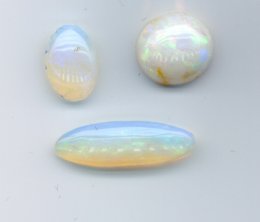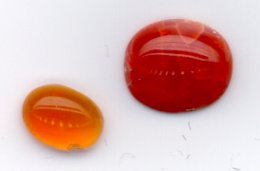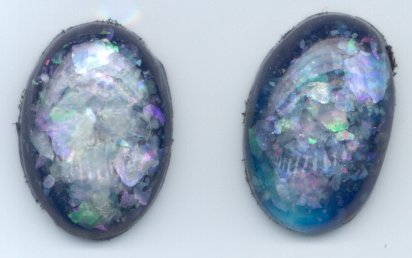If you were born in October, you are one of those people who has a choice for your birthstone. Opal was originally the gem trade's recognized birthstone for October but in 1952 the Jewelry Industry Council suggested that pink tourmaline be an alternate stone to opal. These changes were accepted and approved by the American Gem Society and the National Retail Jewelers Council.
There is a superstition that suggests that it is bad luck to wear an opal if opal is not your birthstone. This superstition probably is not rooted deep in history but only goes back to the early or middle 19th Century. It may even have been an invention of Sir Walter Scott in the novel Anne of Geierstein, published in 1831. It seems that Anne had an opal that that reflected her moods: it shone red when she was angry, blue when she was sad and green when she was happy. When Anne died, the opal faded and lost all of its color. The last observation may have actually been based on a fact: opals can deteriorate and change from a highly colorful, somewhat glassy stone to a rather colorless mass of a chalky silicon dioxide. That is because opals are unstable and are just one of the phases through which gel-like silica (SiO2) can pass on its way to becoming stable crystalline quartz.
Silicon dioxide, SiO2, the same elements that make up quartz is also the constituent of opal. The formula of opal is often written as either SiO2.nH2O or SiO2 + nH2O. Neither formula is really correct. The water is neither a water of hydration as the first formula suggests nor is it unattached to the silica as the second formula might imply. Researchers in Germany have produced a detailed nomenclature of micro- and non-crystalline silica minerals. They listed seven species of opal and characterized the microstructure of each. Fibrous microcrystalline quartz, microcrystalline opals and non-crystalline opals all showed diffuse X-ray small angle scattering that were due to inhomogeneous distributions of water in their microstructures.
Precious opal, or opal with a play of color. The play of color is caused by diffraction of light by the ordered arrangement of closely packed microscopic silica spheres with water enriched spaces between them. The spheres are arranged in octahedrons (base to base pyramids). When the packing of the silica spheres becomes faulted, the striations produce colors that can be seen in reflected light. Play of color is sometimes erroneously called "fire." The term "fire opal" should be used to describe opals with a red body color; they may or may not show play of colors.
Opal is neither very hard (5 1/2 to 6 1/2 on a scale of 10) nor very tough. It has a conchoidal to splintery fracture and is often very brittle. The play colors from the stone can occupy almost any wavelength in the visible spectrum but red and orange are more often preferred than yellow, blue or green. The body color of the opal may be white or tan or bluish. The finest opals have an even distribution of colors in fairly large splotches; pinpoints of light are less desirable. Gray or brown undertones detract from the stone. Some rare opals may show chatoyancy and produce a very fine eye and such stones are desirable even where play of color is insignificant.
Solid opals are the most highly preferred stones but the play of color often is confined to thin layers of horizontally banded opal. Stones called doublets (a thin opal/clear quartz layer) or triplets (a colored back/opal/clear quartz layer) account for many of the opals we see today. Some examples of doublets with opal caps with sodalite backs that produce a blue body color are known. Since opals are not very tough, it is best that ring stones or stones that will be making contact with solid objects be doublets or triplets.
Old World sources for opal were Czechoslovakia and Hungary. Many important opal fields were discovered in New South Wales, South Australia, and Queensland in Australia in the late 19th Century. These fields still produce much of the world's opal but newer sources have been discovered in Brazil, Guatemala, Honduras, and Mexico. In the United States, opal has been found and commercially worked in Nevada, Oregon and Idaho. Common opal (stones without play of color) often have dendritic patterns or nice body colors and these are often called opalite. Strangely, gem opals were not discovered on the African Continent until quite recently when material was reported from Tanzania and Ethiopia. Some synthetic opal is available as both rough and cut stones and some laboratory made glass products have been fairly good opal substitutes.
For Further Reading
- Florke, O. W., Graetsch, H., Martin, B., Roller, K., and Wirth, R., 1991. Nomenclature of micro- and non-crystalline silica minerals, based on structure and microstructure. Neues Jahrbuch Mineralogisches Abhandlungen, v. 163, no. 1, p. 19-42.
- Johnson, M. L., and Koivula, J. I., 1996. Novel opal doublets from Brazil. In Gem News, Gems and Gemology, v. 32, no. 2, p. 136.
- Johnson, M. L., and Koivula, J. I., 1997. More on Opal from Shewa, Ethiopia. In Gem News, Gems and Gemology, v. 33, no. 3, p. 225.
- Johnson, M. L., and Koivula, J. I., 1998. Cat's-eye opal from Tanzania. In Gem News, Gems and Gemology, v. 34, no. 2, p. 138-140.
- Liddicoat, R. T., 1969. Handbook of Gem Identification. Gemological Institute of America, Los Angeles, CA, 430 p.
- Schumann, W., 1977. Gemstones of the World. Sterling Publishing Co., New York, 256 p.
- Shipley, R. M., 1971. Dictionary of Gems and Gemology. Gemological Institute of America, Los Angeles, CA, 230 p.
- Zeitner, J. C., 1996. Gem and Lapidary Materials for Cutters, Collectors, and Jewelers. Geoscience Press, Tucson, AZ, 347 p.



